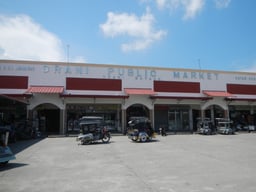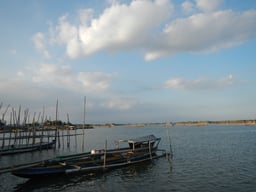Orani, Bataan
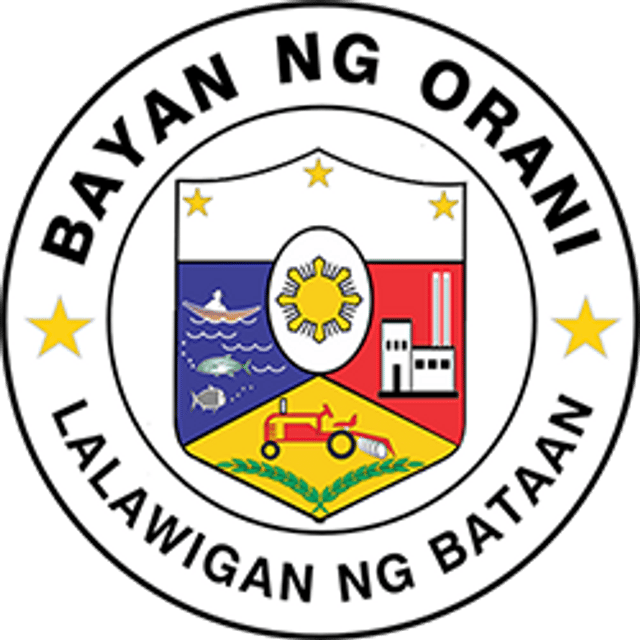
Orani, Bataan

Orani | |
|---|---|
Municipality | |
| Municipality of Orani | |
 Downtown area | |
 Map of Bataan with Orani highlighted | |
 | |
| Coordinates:14°48′N 120°32′E [16] | |
| Country | |
| Region | Central Luzon(Region III) |
| Province | Bataan |
| District | 1st District |
| Founded | 1891 |
| Barangays | 29 (see Barangays) |
| Government | |
| • Type | Sangguniang Bayan |
| • Mayor | Efren Dominic E. Pascual Jr. |
| • Vice Mayor | Emmanuel R. Roman |
| • Congressman | Geraldine B. Roman |
| • Electorate | 49,498 voters (2019) |
| Area | |
| • Total | 64.90 km2(25.06 sq mi) |
| Population (2015 census)[3] | |
| • Total | 66,909 |
| • Density | 1,000/km2(2,700/sq mi) |
| Time zone | UTC+8 (PST) |
| ZIP code | 2108 |
| PSGC [17] | 030809000 [18] |
| IDD:area code | +63 (0)47 |
| Climate type | tropical monsoon climate |
| Income class | 1st municipal income class |
| Revenue (₱) | 160.9 million (2016) |
| Native languages | Mariveleño Kapampangan Tagalog |
Orani is located 107 kilometres (66 mi) north-west of Manila and accessible via the Bataan Provincial Expressway, off Exit 20. It is bounded on the north by Hermosa, south by Samal, west by Dinalupihan and east by the Manila Bay. It has a total land area of 64.90 square kilometres (25.06 sq mi) covering 29 barangays. About 1,231 hectares (3,040 acres) are used for agriculture, 1,943.86 hectares (4,803.4 acres) are forestland, 971.93 hectares (2,401.7 acres) are forest reservation and 1,295.9 hectares (3,202 acres) are reserved for the National Park. The rest are classified as wetland.
Palay, coffee, vegetables, peanut, citrus trees and fruit trees are the major produce. Cutflowers like aster, chrysanthemum and gerbera are locally cultivated while bamboo and jungle vines can be gathered from Orani's forestlands. Aquamarine resources like milkfish, tilapia, prawn, crabs, mussels and oysters are caught in Orani's fishing grounds and fishponds.
Orani | |
|---|---|
Municipality | |
| Municipality of Orani | |
 Downtown area | |
 Map of Bataan with Orani highlighted | |
 | |
| Coordinates:14°48′N 120°32′E [16] | |
| Country | |
| Region | Central Luzon(Region III) |
| Province | Bataan |
| District | 1st District |
| Founded | 1891 |
| Barangays | 29 (see Barangays) |
| Government | |
| • Type | Sangguniang Bayan |
| • Mayor | Efren Dominic E. Pascual Jr. |
| • Vice Mayor | Emmanuel R. Roman |
| • Congressman | Geraldine B. Roman |
| • Electorate | 49,498 voters (2019) |
| Area | |
| • Total | 64.90 km2(25.06 sq mi) |
| Population (2015 census)[3] | |
| • Total | 66,909 |
| • Density | 1,000/km2(2,700/sq mi) |
| Time zone | UTC+8 (PST) |
| ZIP code | 2108 |
| PSGC [17] | 030809000 [18] |
| IDD:area code | +63 (0)47 |
| Climate type | tropical monsoon climate |
| Income class | 1st municipal income class |
| Revenue (₱) | 160.9 million (2016) |
| Native languages | Mariveleño Kapampangan Tagalog |
Geography
Orani is located at 14°48′N 120°32′E [19] .
According to the Philippine Statistics Authority, the municipality has a land area of 64.90 square kilometres (25.06 sq mi) [2] constituting 4.73% of the 1,372.98-square-kilometre- (530.11 sq mi) total area of Bataan.
Barangays
| PSGC | Barangay | Population | ±% p.a. | |||
|---|---|---|---|---|---|---|
| 2015[3] | 2010[5] | |||||
| 030809025 | Apollo | 2.9% | 1,955 | 1,857 | ▴ | 0.98% |
| 030809001 | Bagong Paraiso (Poblacion) | 4.2% | 2,835 | 2,276 | ▴ | 4.27% |
| 030809002 | Balut (Poblacion) | 2.0% | 1,355 | 1,397 | ▾ | −0.58% |
| 030809003 | Bayan (Poblacion) | 9.0% | 6,018 | 5,363 | ▴ | 2.22% |
| 030809004 | Calero (Poblacion) | 2.1% | 1,438 | 1,686 | ▾ | −2.98% |
| 030809016 | Centro I (Poblacion) | 0.7% | 501 | 404 | ▴ | 4.18% |
| 030809006 | Centro II (Poblacion) | 0.6% | 431 | 400 | ▴ | 1.43% |
| 030809007 | Dona | 1.9% | 1,249 | 1,213 | ▴ | 0.56% |
| 030809026 | Kabalutan | 3.7% | 2,462 | 2,099 | ▴ | 3.08% |
| 030809008 | Kaparangan | 4.5% | 3,021 | 3,123 | ▾ | −0.63% |
| 030809027 | Maria Fe | 3.2% | 2,146 | 2,046 | ▴ | 0.91% |
| 030809009 | Masantol | 1.0% | 690 | 736 | ▾ | −1.22% |
| 030809010 | Mulawin | 6.5% | 4,380 | 3,534 | ▴ | 4.17% |
| 030809011 | Pag‑asa | 3.7% | 2,486 | 1,927 | ▴ | 4.97% |
| 030809005 | Paking‑Carbonero (Poblacion) | 1.7% | 1,164 | 1,272 | ▾ | −1.68% |
| 030809012 | Palihan (Poblacion) | 3.9% | 2,581 | 2,452 | ▴ | 0.98% |
| 030809013 | Pantalan Bago (Poblacion) | 3.4% | 2,250 | 2,130 | ▴ | 1.05% |
| 030809014 | Pantalan Luma (Poblacion) | 8.3% | 5,563 | 5,026 | ▴ | 1.95% |
| 030809015 | Parang Parang (Poblacion) | 2.1% | 1,407 | 1,265 | ▴ | 2.05% |
| 030809028 | Puksuan | 1.0% | 645 | 661 | ▾ | −0.47% |
| 030809017 | Sibul | 1.9% | 1,283 | 1,084 | ▴ | 3.26% |
| 030809018 | Silahis | 0.8% | 510 | 484 | ▴ | 1.00% |
| 030809029 | Tagumpay | 3.0% | 2,003 | 1,833 | ▴ | 1.70% |
| 030809019 | Tala | 2.2% | 1,467 | 1,337 | ▴ | 1.78% |
| 030809020 | Talimundoc | 3.7% | 2,493 | 2,135 | ▴ | 3.00% |
| 030809021 | Tapulao | 7.5% | 5,023 | 4,745 | ▴ | 1.09% |
| 030809022 | Tenejero (Poblacion) | 2.9% | 1,968 | 1,706 | ▴ | 2.76% |
| 030809023 | Tugatog | 10.2% | 6,856 | 6,145 | ▴ | 2.11% |
| 030809024 | Wawa (Poblacion) | 1.1% | 729 | 763 | ▾ | −0.86% |
| Total | 66,909 | 61,099 | ▴ | 1.74% | ||
Demographics
| Population census of Orani | |||||||||||||||||||||||||||||||||||||||||||||||||
|---|---|---|---|---|---|---|---|---|---|---|---|---|---|---|---|---|---|---|---|---|---|---|---|---|---|---|---|---|---|---|---|---|---|---|---|---|---|---|---|---|---|---|---|---|---|---|---|---|---|
|
| ||||||||||||||||||||||||||||||||||||||||||||||||
| Source: Philippine Statistics Authority[3][5][6][7] | |||||||||||||||||||||||||||||||||||||||||||||||||
In the 2015 census, Orani had a population of 66,909.[3] The population density was 1,000 inhabitants per square kilometre (2,600/sq mi).
Government
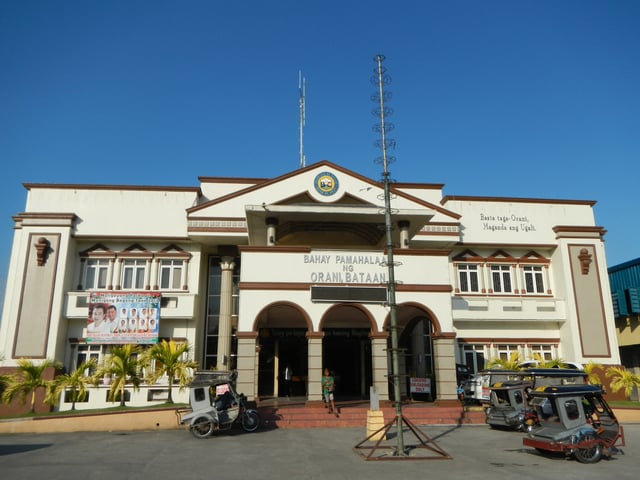
Municipal hall
Pursuant to the Local government in the Philippines",[8][9] the political seat of the municipal government is located at the Municipal Hall. In the History of the Philippines (1521–1898), the Gobernadorcillo was the Chief Executive who held office in the Presidencia. During the American rule (1898–1946) (History of the Philippines (1898-1946)), the elected Mayor and local officials, including the appointed ones held office at the Municipal Hall. The legislative and executive departments perform their functions in the Sangguniang Bayan (Session Hall) and Municipal Trial Court, respectively, and are located in the Town Hall.
Orani, Bataan's incumbent elected officials are - Mayor Efren Dominic E. Pascual, Jr. and Vice Mayor Godofredo Bongco Galicia, Jr., including 8 Councilors or Sanguniang Bayan Members:[10][11] Emmanuel Bati Roman, George Vianzon Mangaliman, Mayfair Bongco Sibug,Francis Sevilla Dela Torre, Renato Rodriguez Bugay, John Paul Apostol,Lilian Flores Tongco and Rolando Bernaldo Mina. They hold office at the second floor of the Town Hall, particularly the Office of the Mayor and Sangguniang Bayan Session Hall, respectively.
The 2nd Municipal Circuit Trial Court of Orani-Samal, MCTC Judge Ma. Cristina J. Mendoza-Pizzaro holds office in her sala located at the second floor of the MTC building at the back of the Town hall.
The municipality passed an ordinance that protects its people against discrimination based on disability, age, civil status, health status, ethnicity, religion, sexual orientation, gender identity, and expression in January 2019 - becoming the first Bataan local government unit to do so.[12]
Educational institutions
Attractions

Our Lady of the Most Holy Rosary Parish Church
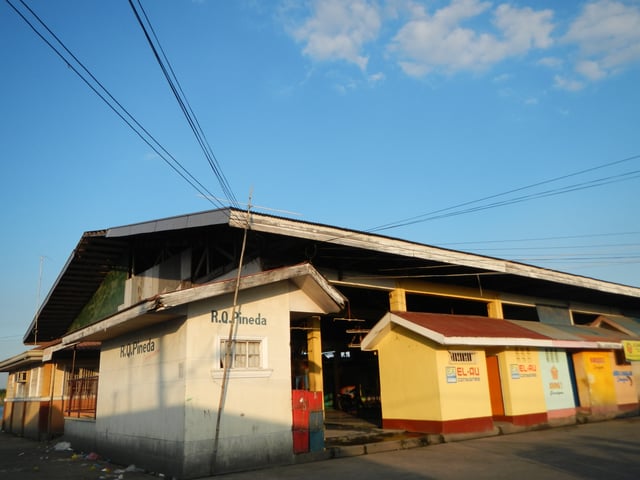
Orani Fish Port
Orani's attractions, events and historical landmarks include:[13]
Holy Rosary Parochial Institute — Mango Tree
Orani People's Park, center of Poblacion, Plaza
Orani Fish Port
Seventh-day Adventist - Talimundoc
The 1714 Orani Church, commonly known as the "Our Lady of the Most Holy Rosary Parish Church of Orani" ("Our Lady of the Rosary of Orani", "Nuestra Señora del Rosario Parish Church", "Church of Orani" or "Virgen Milagrosa Del Rosario del Pueblo de Orani Shrine") is a Neoclassical (heritage) Diocesan Marian Shrine and Pilgrimage church (recognized by the 1959 Vatican's Papal Bull, located in Poblacion).
Our Lady of Orani
Orani ₱42.7 million new municipal building, located at the center of the old Poblacion, in front of the Orani Church. It has a total floor area of 2,916 square metres (31,390 sq ft), including the roof deck (648 sq. m.) On August 4, 2005, Mayor Efren Pascual Jr. constructed the building which was inaugurated on May 26, 2007.
The Multi-purpose Gym
Orani Cockpit
Orani Public Market
Death March Marker (Silahis), Bataan Death March. Kaparangan was used as a temporary prisoners’ camp by the Japanese soldiers starting on April 11, 1942, the second day of the infamous “Death March”. To commemorate the pitiful event, the National Historical Institute constructed a bronze memorial at the corner of Barangay Silahis and the Bataan National Road in 1987.
Tamarind Ridge — a 14-hectare development situated at Barangay Tugatog, Orani, Bataan
Bataan Peninsula State University - Orani Campus
Pawikan Festival[14]



